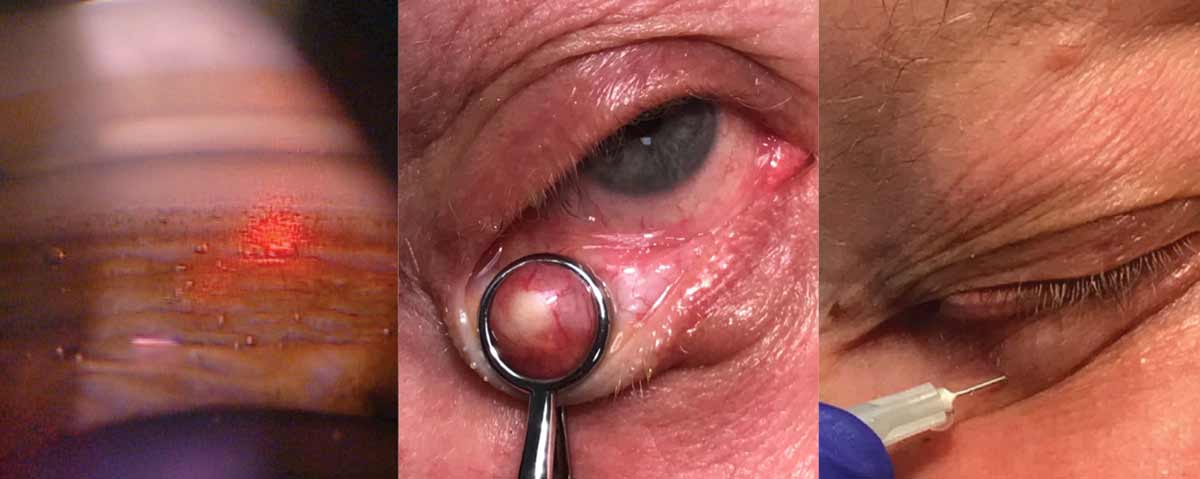 |
If SB 129 is eventually passed, the scope of optometry in Ohio would finally reflect the profession’s current educational and training standards and help increase the efficiency of the eyecare workforce to meet the needs of an aging population. Photos left to right: Nate Lighthizer, OD, Jackie Burress, OD, Corri Collins, OD. Click image to enlarge. |
Optometrists in Ohio haven’t seen an update to their scope of practice in more than 15 years. Hopeful to change this in the next two years, the state introduced SB 129 to the Senate Health Committee on June 28 just before the legislature recessed for the summer. The bill, sponsored by Senator Jerry Cirino, proposes to allow optometrists to perform the following procedures:
- Removal of benign lesions, cysts and skin tags (including incision and curettage of a chalazion or stye and removal and biopsy of skin lesions with low risk of malignancy, such as cysts and skin tags)
- Injections (excluding intravenous or intraocular)
- In-office noninvasive laser procedures (laser capsulotomy, trabeculoplasty and peripheral iridotomy)
The two-year bill also proposes to update pharmaceutical regulations to allow optometrists to treat any eye condition, as well as allow for the use of epinephrine injection in cases of anaphylactic shock. Additionally, it states that authority would be granted to the Vision Professionals Board to establish training and infection control standards.
The Ohio Optometrist Association (OOA), a leading group of advocates for the bill, notes that since the early 2000s when the last scope law was passed in the state, there have been disruptive advances in technology, education and training standards in the profession. Compounding this issue is the nation’s aging population and shortage of ophthalmologists, which puts increasing demand on the need for eyecare services for diseases such as glaucoma and macular degeneration.
State Budget WinAt the end of July, Ohio Governor Mike DeWine signed a new state budget into law granting a 15% increase in Medicaid reimbursement for vision and eyecare services. In addition to this, the budget allocates $2.5 million for a children’s vision initiative, which will be used toward the creation of a statewide children’s vision program aimed at providing comprehensive eye care to kids who do not have an eye doctor. The OOA reports that its charitable foundation, the Ohio Optometric Foundation, will be taking the lead on the development of the statewide vision program. |
More and more states are recognizing that optometrists can be part of the solution, with six passing scope expansion legislation in the last five years. There are also several states besides Ohio with one- or two-year scope bills at varying points of the legislative process, including New Jersey, California and Nebraska.
In a recent report, the OOA highlighted several reasons why an update to the state’s practice scope is crucial for doctors, patients and the state’s healthcare system. The first reason cited is to improve access to care and decrease wait times for patients in need of these essential procedures. Secondly, the association argued that the law will create a more efficient, team-oriented approach to the delivery of care. It noted that allowing ODs to perform these minor procedures (such as capsulotomy after cataract surgery, trabeculoplasty to lower intraocular pressure in glaucoma patients and laser peripheral ididotomy to prevent closed-angle glaucoma) will help reduce the burden placed on ophthalmology practices and allow them to focus more of their time on advanced procedures that fall outside of the skills and training of optometrists. The report further pointed out that the procedures proposed in SB 129 represent a small percentage—around 4%—of the scope of ophthalmology.
The third reason the OOA argues SB 129 is necessary is that it will help Ohio maintain a well-trained eyecare workforce by aligning the state’s practice scope with that of surrounding states (including Indiana, Kentucky, West Virginia, Colorado and Virginia). The report also notes that 71% of graduating optometrists say that a state’s scope of practice is a factor in determining where to practice, and graduates often cite the inability to practice optometry to the full scope of their training as a primary reason for leaving the state.
The OOA is hopeful that Health Committee hearings will be scheduled for SB 129 following the summer recess. It advises ODs who are interested in supporting the legislation to contact the OOA at [email protected].

